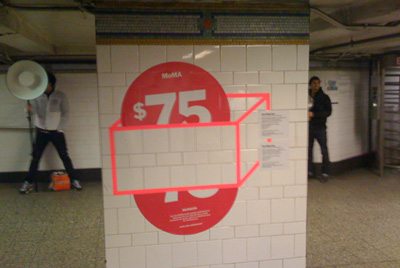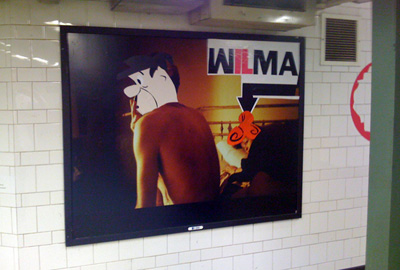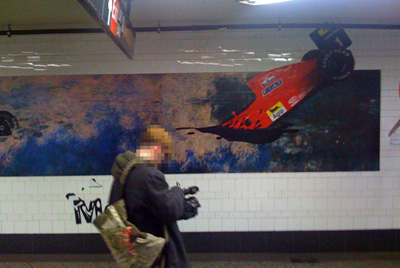
Viral Marketing is all laughs -- until the law gets involved. When does negative press actually become bad press? Is it when you get subpoenaed?
- Vandalism is part of the subway advertising medium.
- I told MoMA they should make two sets of every ad.
- The campaign was a way for MoMA to participate in the community in an authentic way.
- I could have stopped [Poster Boy].
Regardless of whose decision it was, the press covered the vandalism as a deliberate and planned action orchestrated by Doug and The Happy Corp. For Doug, unfortunately, the situation is playing out as if he did it.
As Jaeger relays it, MoMA hired The Happy Corp to reach a more youthful audience. The Happy Corp won the contract on a project basis based on their idea that the MoMA experience could be brought to the masses through a subway station domination. The concept was simple and brilliant: turn a subway stop into the MoMA with copies of actual pieces of art.
Enter Poster Boy, who in one fell swoop illegally enhances many of the masterpieces with self-expressive artistic interpretation -- or vandalizes them, depending on how you look at it. The New York Post and New York Magazine cover the incident as part of the campaign designed by The Happy Corp, with supportive quotes from Jaeger. Thousands of additional publications pick up the story, and MoMA fires Jaeger and The Happy Corp. Jaeger faces legal consequences and possible criminal charges. Jaeger is sad. Jaeger is now regretful about how this situation played out.
I believe that this was all positive for Jaeger until 1) he was fired, and 2) he faced legal repercussions.
My ultimate question is whether MoMA knew of and approved the plans prior to their execution. Once the press exploded, they had no choice but to fire Jaeger -- but were they privately in on the stunt from the beginning?
I was recently pitching a viral concept to a new client. This client is a relatively large and conservative company, and the pitch was to a table of about 15 people from the marketing team, including the CEO. While the room responded positively to the concept, the CEO shot down the idea, saying it was too much of a risk. Though I disagreed, he's the CEO of a couple-hundred-million-dollar company -- what could I do? After the pitch, he unexpectedly called me into his office. He told me that he loved the concept, but couldn't "publicly" endorse it in front of his team. He then said, if, however, the campaign happened "organically," without his or his company's participation, he wouldn't be angry. Actually, he said, he would appreciate it.
Could MoMA have played a similar role in this situation? If Doug participated in the vandalism -- and I'm not saying he did -- I doubt he would have done it without approval.

It's important to assess whether this campaign is affecting MoMA positively. Based on impressions, coverage, eyeballs, attention, there is no argument that the subway campaign and subsequent vandalism is delivering multiple times over on the investment. Given that MoMA is completely evading responsibility for the vandalism, I struggle to find a negative angle on this situation from their perspective. To the contrary, the story is all the more impactful because people are responding so strongly to it. Audiences investigating the vandalism are also investigating the artwork. To understand the vandalism, you first need to understand the art in its original form. This includes learning artists' names, engaging with the art itself, and understanding and appreciating the original pieces. The result can be considered a greater education about and familiarity with MoMA's collection.

I am not advocating that vandalizing art or misleading your consumer base is a positive strategy, but in this specific case, MoMA was able to benefit from the extra attention without having to bear the repercussions of taking responsibility for the act. If anything, from a branding standpoint, the vandalized art was made sacred, while MoMA appears to be the victim of reckless marketing.

Jaeger calls himself the biggest loser in this situation. He sounds like something of a martyr when he recounts the experience, almost framing his work and his reaction as a sacrifice he made for the client. In the end, the actual decision making was irrelevant; only public perception matters. The public now sees Doug as a brilliant but arrogant marketer responsible for vandalizing his own company's work. MoMA and its collection, meanwhile, received tremendous attention without evident harm to the brand.

In the long term, this mess won't have any adverse effect on MoMA: a Google search for "MoMA" doesn't generate Poster Boy-related stories until page three. As for Doug, he's smart enough to rebound. This incident will continue to generate skepticism and questions and might prevent other brands from trusting him, but eventually the collective memory of the episode will fade. But while people will forget, the articles that are searchable on Google will not disappear. As a result, this incident will remain something of a cyberspace scarlet letter for Jaeger. Some will praise him, some will criticize him, but Doug won't fully evade the questions about the "MoMA situation" for years.
The MoMA/Happy Corp relationship:
Jaeger and The Happy Corp have had a longstanding relationship with MoMA. On behalf of Pocket Change, an online media property we publish at Samson's Barber, I competed in a Happy Corp-produced corporate vending machine eating competition against MoMA. It was an intense battle, but we emerged victorious. Here's the video proof.
Official Statement From The Museum of Modern Art:
No one at The Museum of Modern Art had any role in or prior knowledge of the acts of vandalism committed against posters in the Museum's installation in the Atlantic Avenue subway station. On February 27 we ended all work to be done by Doug Jaeger and thehappycorpglobal on this project and all others, and have completely severed our relationship with the company. The Museum deplores any kind of vandalism and is profoundly distressed that the posters were defaced. The images that were damaged have been replaced.
Here's my interview with Doug Jaeger:
Doug Jaeger Interview Transcript
Jeremy Abelson: Doug, What is the Happy Corp?
Doug Jaeger: "The Happy Corp is a company I started, out of my apartment, in 2003. I had worked in several advertising agencies, very large ones, J.Walter Thompson and TWAChiatDay. I ended up working on a lot of businesses I didn't believe in. When I turned about 28 I realized I really had been kind of spending my time at ill and decided to do something with a positive agenda."
JA: Who are you doing work for?
DJ: We worked on a conference in Miami called M3. We worked with Flavor pill, early on, helping them with their brand and helping connect them to advertisers...we did a year with the Museum of Modern Art, we're currently with Vh1, and idealist.org, helping them with their identity, and then Werewolf Collections. And then on top of it we throw these LVHRD parties to get creative people together.
JA: Why did the art director's club think you were deserving of the title of president at such a ripe age?
DJ: I really think it was a strategic decision to put someone young and kind of crazy in an organization that has been traditionally very stayed. I had made a pretty significant impact with a small amount of people.
JA: Let's talk the MoMA, why did you autonomously enhance the ad campaign that you had produced for the institution?
DJ: Okay, um, ...well I can say fairly that I did not enhance the campaign. I think there has been lots of press about the situation.
JA: Is all press good press?
DJ: Um, I would say not considering that I'm fired and that there is legal action against me. The media has gotten out of control. New York Magazine and the New York Post published a lot of things irresponsibly without even checking the facts.
JA: Did the campaign receive more attention because of the modifications made to it?
DJ: Probably, but for what? I mean it received attention for being slashed up. In some circles that's really cool, but, ya know my parents were like 'we're really disappointed in you'.
JA: What were you thinking during the decision making process with this campaign?
DJ: Anyone who buys subway advertising knows that it will get vandalized, it's part of the medium. In the context of this, whether it was planned or not, it happened. When we originally thought of the campaign we imagined people would steal the work.
JA: So what are you saying is that this type of vandalism cannot be contained?
DJ: That general idea is the premise of even why there was this attack on the station, because it's inevitable. I really feel that it's awful, because the objective of the campaign was to provide a 'MoMA like' experience to passengers.
JA: Why was the alteration of the ads a strategic risk you were willing to take?
DJ: I don't know if it was a risk that I took. I didn't cut any posters. Cutting posters is not my idea. It's something that we saw, my team, as part of the vernacular of this medium. If you participate in a subway campaign, one of this high profile, there is an inevitability that people partaking in this medium would see it as an opportunity to participate.
JA: Was there any benefit for you?
DJ: When you allude to the fact that a lot of parties benefit, I think of anyone that's not benefitting right now, it's me. I'm really not. I've been extremely stressed out about it and I've had to hire a legal defense because I have a company that provides income for people, and if I'm distracted by defending myself legally, I don't perform for those clients.
JA: Who is prosecuting you?
DJ: Well I'm not being prosecuted necessarily, but the DA's office in Brooklyn has been inquiring about the situation. I'm not experienced in these kind of matters. I'm kind of one to talk dangerously about what's occurred.
JA: Without the negative press, what would have been positive impact of that kind of artistic alteration to the MoMA campaign?
DJ: I think it's an opportunity for museums, for the MoMA, to participate in [the artistic] community in a very authentic and real way.
JA: Do you think the MoMA was in need to reinvent itself to reach the new market of youthful artists?
DJ: In general arts institutions have an aging demographic, it is constantly getting older, and part of that is because they need lots of money, and it just happens to be that lots of money typically tends to be greater found at the latter end of the spectrum. Yes, the work that we did genuinely connects a younger audience to an institution.
JA: Did MoMA put you in a position to reach a younger more authentic audience?
DJ: We were chosen because of the idea that we came up with and the idea was to do a station domination.
JA: Do you think this damaged your credibility in the industry?
DJ: Yeah, I mean when you publicly get fired obviously you did something wrong.
JA: What is the feedback within the industry?
DJ: I've received e-mails from the entire industry saying 'genius, wish I had thought of that, that is so incredible'... but a lot of people have said, ya know, 'you're a media whore, why did you do that, so inappropriate, this person deserves what they get'.
JA: Do you think MoMA wanted to fire you or did they feel compelled?
DJ: I think as an organization they are very fair and if I was in their position I might make a similar decision. I respect what they've done.
JA: Do you think future clients will have issues trusting you?
DJ: I'm hoping at some point I can clear it up publicly. There is always the question of what happened with MoMA.
JA: Do you think on a personal and professional level this is going to change your approach in the future?
DJ: Yes, actually in fact, I do believe that what does not kill you makes you stronger. This experience has forced me to examine the emphasis of the business I am in.
Jeremy Abelson is the cofounder of Samson's Barber. Follow Jeremy Abelson on Twitter.